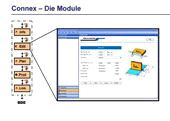Workflow
Connex – the new workflow system from Muller Martini

Monday 28. April 2008 - Postpress: Muller Martini presents the continuous digital workflow
Digital workflow, and hence the complete electronic networking of sub-processes, is becoming a central issue in postpress. Muller Martini continues to rigorously pursue the path forged at drupa 2004 and, in Connex, will be presenting at drupa 2008 a revolutionary new workflow system that satisfies the highest of demands.
Using Connex, all Muller Martini machines, from stand-alone machines to complex production systems, can be networking with the customers Management Information System (MIS). In addition, Connex permits the integration of older machines or machines from other suppliers. Muller Martini was attaching great importance to digital workflow as early as drupa 2004. And at drupa 2008, the Swiss company will again be pointing the way in the postpress sector. Because as one of the founding members of CIP4 (Cooperation for Integration of Processes in Prepress, Press and Postpress), Muller Martini has for years assumed a leading position in the field of processing and, in Markus Schluep, chairs this sector.
Today, CIP4 has 310 members worldwide (as of 28.3.2008) and the JDF/JMF standards propagated by CIP4 have established themselves in data exchange with different systems in the industry. Increasing along with cost pressure is the demand in businesses, also in finishing, to network partial processes electronically and to import data generated in prepress or whilst printing. This ranges from manual data input at a terminal near the machine to the integration of various counters and encoders in the entire line.
In simple terms, digital workflow is nothing more than automation of existing workflows. It is a replacement for various production reports, job ticket jackets and manual entries. Here the JDF (Job Definition Format) assumes the function of the previous “work bags”. It allows automatic machine set-up based on computer files. The JMF (Job Messaging Format) on the other hand is regarded as the “messenger” of former times, delivering data from machine to machine in work bags. This format is used today as a communication standard between individual computers of JDF machines.
What can Connex do?
But where do these files come from? Or put another way: What does a customer require if the digital workflow is to be installed? – As a prerequisite, the customer must have the necessary software to be able to generate JDF/JMF files. This can be either with an MIS or an appropriate prepress process. In addition, the customer requires a network in the production, a workflow system such as the new Connex, and JDF-enabled machines must of course be available.
Over the years, Muller Martini has been able to gain extensive experience with digital workflow and to implement a series of continuous, networked solutions in saddle stitching and adhesive binding. Some Muller Martini customers have since been awarded the coveted CIP4 Award for progressive organization.
Muller Martini developed Connex on the basis of this expertise. The prominent benefits of the new workflow system lie in the fact that, in Connex, Muller Martini now has a single interface between all Muller Martini machines and the MIS of the customer – regardless of whether this is a stand-alone machine or a complete production system. Connex is also compatible with all prevalent management information systems that conform to the CIP4 standards.
Connex is made up of different modules that perform the following tasks:
Connex.Info makes production transparent by allowing a continual overview of the production lines and statuses of the respective jobs. Furthermore, the entire production system can be displayed graphically and analyzed.
Connex.Edit allows the creation and editing of jobs in the JDF format for customers who have no MIS or appropriate prepress software. Connex.Edit can also be used to edit job files locally.
Connex.Plan allows the scheduling of jobs in the sense of sorting, grouping and planning. Jobs can be allocated to machines automatically or manually. These machines can also be non JDF-enabled machines.
Connex.Prod executes the JDF and communicates with all the machines involved. The production settings are taken from JDF files and need not be re-entered. Operational data arriving during processing is captured and collected and can be retrieved continually.
This flexible workflow system allows all Muller Martini machines to be integrated into one continuous digital workflow. With the installation of the additional Connex.Link module, Muller Martini provides the ability to even include older, non JDF-enabled machines, or machines from third-party manufacturers into the workflow. Besides the total solution with MIS and prepress, Connex can also be run as a fully functional stand-alone solution (without MIS) that can generate jobs itself or display job information. This solution is of particular interest to purely processing firms or companies that are looking to enter into digital workflow on a step-by-step basis.
Muller Martini will be demonstrating digital workflow with the Connex system at their drupa exhibition stand (Hall 14, B38). Saddle stitchers and perfect binders from Muller Martini will be networked to an MIS from Hiflex via Connex.
